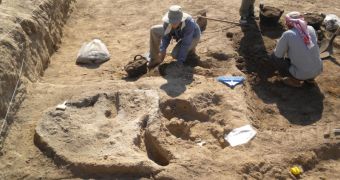At the junction of the Euphrates and Balikh rivers, in what is now northern Syria, archaeologists are discovering more and more details about a prehistoric civilization that lived here before the invention of the wheel. The location, called the mound of Tell Zeidan in the Euphrates River Valley, near Raqqa, has remained undisturbed for more than 6,000 years, experts say. Though it is surrounded by irrigated land that has been used extensively over the millennia, the mound itself, standing some 48 feet high, has remained undisturbed throughout the ages.
Now, researchers from the Oriental Institute at the University of Chicago, in the United States, and colleagues from Syria, are working on gaining more clues about the culture that lived at this location so long ago. Emerging clues would seem to indicate that the Ubaid culture formed the basis of urban civilization in the entire Middle East, a long time before the wheel was invented. According to the investigators, it would appear that the society had a rich tradition of trading, engaging in copper metallurgy, and producing beautiful pottery.
The Tell Zeidan civilization developed between 6,000 and 4,000 BC, and it apparently was one of the first societies in the world to experience the separation of the classes, depending on social status and wealth. Additionally, it seems to have appeared and grown just shortly after the first ancient civilizations emerged in the Middle East, including Summer. Shortly after appearing, the Tell Zeidan learned to mark the ownership of goods using seals. This was something only the wealthy apparently did, which is what led researchers to hypothesize that the society was divided into classes.
“This enigmatic period [5300 to 4000 B.C.] saw the first development of widespread irrigation, agriculture, centralized temples, powerful political leaders and the first emergence of social inequality as communities became divided into wealthy elites and poorer commoners,” the Director of the UC Oriental Institute, Gil Stein, explains. He is also the leader of the expedition conducting the digs at the Syrian location. Funding for the study came from the US National Science Foundation (NSF) Social, Behavioral & Economic Sciences directorate, through the archeology program.

 14 DAY TRIAL //
14 DAY TRIAL //